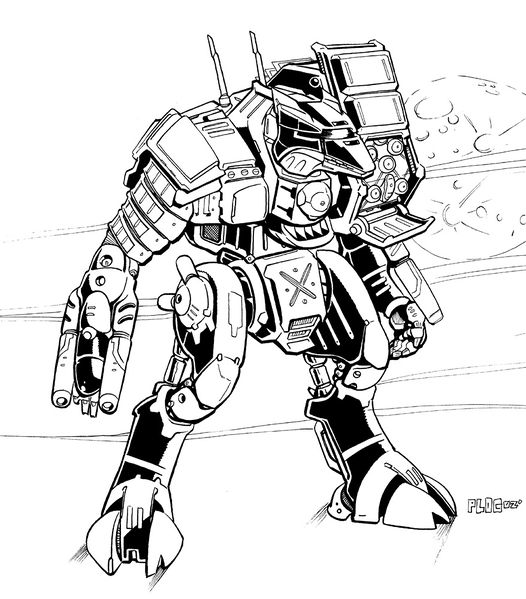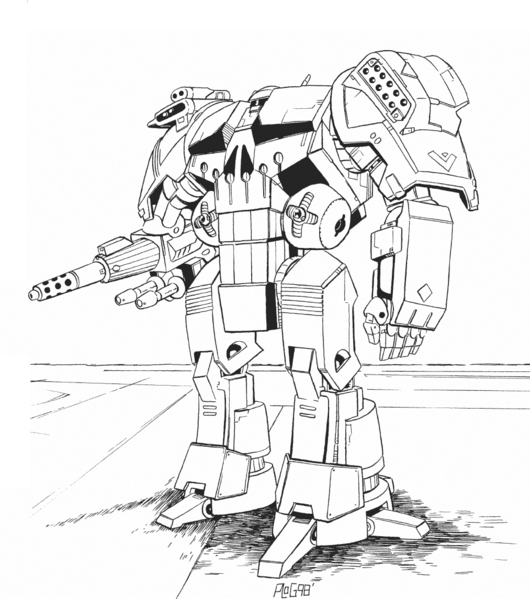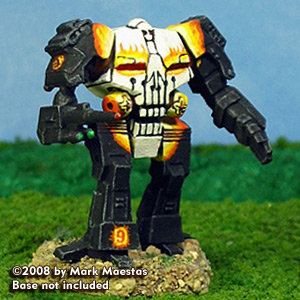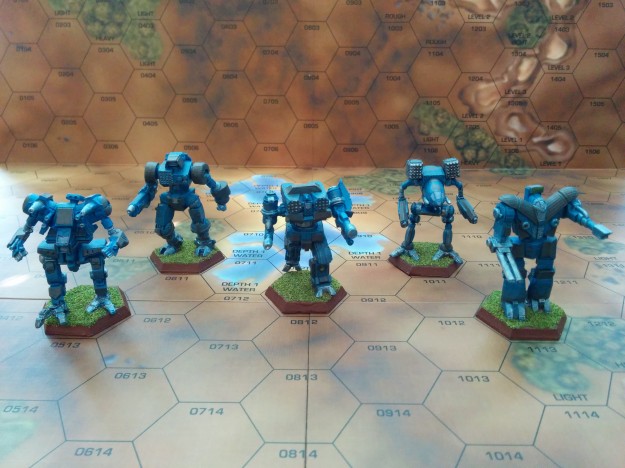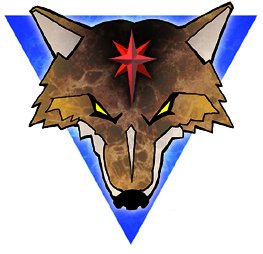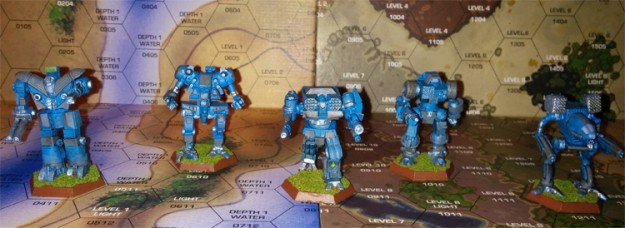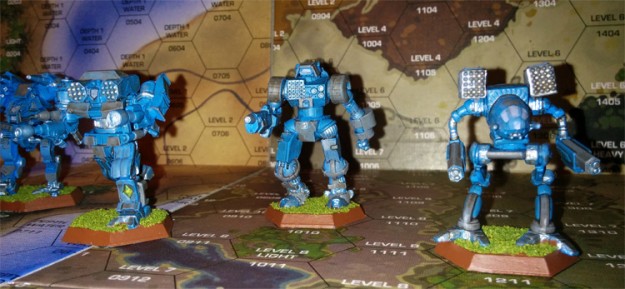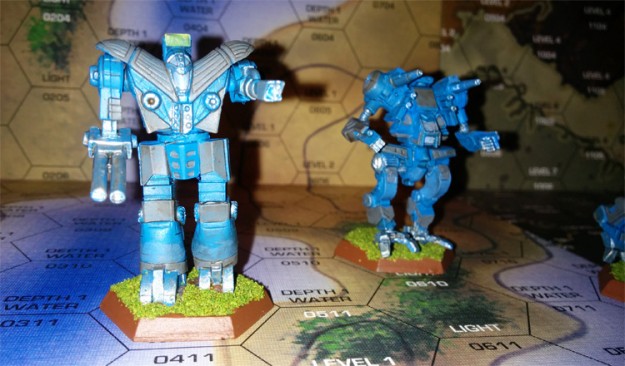While not as adaptable or flexible as OmniMechs, the Clans as a whole still see the indelible value of standard BattleMech technology. Even in their limited configuration state, when equipped with their venerable technology, Clan second line BattleMechs provide some of the most solid, dependable, and fun designs in the game. From the well-known Mad Cat Mk II to the iconic Kodiak and the re-imagined IIC lines, Clan second line designs range all the way from amazing to completely laughable.
Second line `Mechs are generally used for defensive operations, with some exceptions, and as such generally use less expensive and more stable parts and technology. Standard Engines are commonly found in second line designs, as well as standard chassis as opposed to Endo Steel construction. Ferro-Fibrous Armor, however, still appears to be the normal standard even with second line designs.
Today I want to take a look at two second line BattleMechs that were designed a few years, and couple thousand light years, apart from each other. These two `Mechs were designed to fill similar roles in their respective Clans’ toumans, and each Clan went about the job a different way. In the case of Clan Coyote, they needed a lighter and faster design that could deliver a good punch standing alongside heavier units while still possessing enough speed to pursue attackers. For Clan Ghost Bear, the need for a strong and dependable second line design was apparent from the moment they arrived in the Inner Sphere and began taking and holding worlds.
Even with some of the differences in need, Clans Coyote and Ghost Bear ended up designing and producing similar BattleMechs that fit the needs of each Clan near perfectly. Let’s dig into the histories, similarities, differences, and ultimately a comparative match-up, of the Rabid Coyote and the Ursus. For the purposes of this article, we are going to look at just the standard variants of both BattleMechs.
Rabid Coyote
Clan Coyote created the Rabid Coyote out of a need to support their highly successful assault class designs, such as the Canis and Savage Coyote. The larger `Mechs lacked a speed that was necessary for pursuing fleeing foes and suffered from the ability to engage faster enemies that could redeploy and attack from new angles.
During the time period following the Great Refusal, in the upheaval and scramble for new resources that followed the vacuum of Clan Smoke Jaguar’s demise, Clan Coyote did not fare well. Clan Coyote, once at the top of Clan heap, now found itself on the edge of irrelevance. Even the introduction of Advanced Tactical Missile technology, solely a product of Clan Coyote, was not enough to catapult the Clan back into the spotlight.
The Khans needed something to help their touman, help their warriors on the battlefield, and help stabilize their decline. The future of the Clan was riding on the success of their next venture.
Designed as a bodyguard unit for heavier `Mechs, the Rabid Coyote was abjectly rejected upon arrival by the Warriors to which it was assigned. The concept that a BattleMech should play bodyguard and support to another BattleMech was one that Coyote Trueborns especially despised.
Regardless of the reception, the Rabid Coyote appears to be here to stay. Field tests and trials by fire have been positive for the new design, and Clan Coyote is committed to keeping the BattleMech in its ranks.
Armaments and Capabilities
Likely, at least in part, to further highlight their new technology, the Rabid Coyote‘s main armament is a single ATM 12 set in its left torso. The ATM has one ton of ammo for each type of ATM missile. This main weapon is backed up by four Medium Pulse Lasers, two in each arm, and an Electronic Countermeasure Suite (ECM) located near the cockpit. Ample armor protection, eight and a half tons of Ferro-Fibrous Armor, for a 55 ton BattleMech is provided, and battlefield staying power is backed up by its use of a standard engine, all mounted on an Endo Steel chassis. 12 Double Heat Sinks allow the Rabid Coyote to remain fairly cool when utilizing its entire arsenal.
This design on paper is as solid as they come. Perhaps a bit slow for a Clan Medium, in its intended role the 5/8 speed works out just fine, especially when compared to the speeds of the BattleMechs in whose company the Rabid Coyote is most commonly found.
Ursus
Rolling off the production in 3059, seven years before the Rabid Coyote appeared in Clan Coyote’s touman, the Ursus was a triumphant accomplishment for Khan Bjorn Jorgensson and for Clan Ghost Bear. The first Clan BattleMech produced completely within the Inner Sphere, the Ursus was designed to fill a painful gap in Clan Ghost Bear’s second line forces.
The Ursus was designed somewhat with a “less is more” mentality that enforced its purpose. Using simple technologies like a standard chassis and engine, the design is dependable and able to take a lot of punishment for a fifty ton Medium `Mech. Received well by the touman as a whole, the majority of the first production runs found assignment to units primarily along the Draconis Combine border and saw action against both DCMS and Clan Nova Cat forces.
While not specifically created as a bodyguard unit, as in the case of the Rabid Coyote, the Ursus still found use in the role as it was soon assigned to duty alongside larger and slower second line BattleMechs like the Kodiak and Grizzly. In this role, the uncharacteristically slower speed of the Ursus did not feel at all like a liability, and the machine continued to shine as a defensive unit. Many commanders now consider the Ursus to be a quintessential companion to slower Heavy and Assault second line BattleMechs.
Armament and Capabilities
Thanks in part to its smaller engine, and the use of eight and a half tons of Ferro-Fibrous Armor, the Ursus packs an arsenal of weaponry that outclasses almost any other Clan second line Medium and many OmniMechs of its weight class. Its main armaments are on its right arm, which houses an Extended Range Large Laser and two Medium Pulse Lasers. These are backed up at long and medium ranges, respectively, by an LRM 10 on its left arm and an SRM 6 mounted in its center torso. Adding a final touch to the brawler nature of the BattleMech, each side torso sports an Extended Range Medium Laser, adding to the design’s ability to engage effectively and decisively at medium range. Finally, the entire BattleMech is protected by an integrated Electronic Countermeasure Suite mounted in its right torso. 16 Double Heat Sinks allow the Ursus to stay just about as cool as the Rabid Coyote when using its vast array of weapons.
At first glance, it just doesn’t seem like it is possible to fit all of that into a fifty ton chassis, but there it is. The secret to the Ursus is in its speed. 4/6 is painfully slow even for some Clan Heavy `Mechs, but in its intended role as a defensive and bodyguard unit, the Ursus just plain does not need to worry about being speedy.
Head to Head
Each of these BattleMechs represents a different take on what are essentially similar battlefield roles. The Rabid Coyote was additionally designed to emphasize pursuit after a successful defense, and the Ursus was designed to maximize overall defensive capability and sturdiness supporting larger `Mechs. Both designs are most commonly seen in the company of heavier designs, providing escort and support for the larger machines.
Both `Mechs’ incorporation of ECM suites makes them invaluable on the battlefield in the company heavier units that are not commonly equipped with such countermeasures.
Also, it is highly unlikely that either of these two BattleMechs have ever seen each other on the battlefield. First, they are designed for the same role, not opposing roles, which means it would be more than exceedingly rare to see one or the other in an attacking force where the other is present among the defending forces. Mostly, though, is the fact that the Rabid Coyote is deployed by a Clan that is located totally in the Clan Homeworlds, and the Ursus is deployed by a Clan that is now completely located in the Inner Sphere. The Ursus was only ever produced in the Inner Sphere and was never transported to Clan space during the short time between its initial production and the Ghost Bears’ exodus from Clan space.
While Clan Wolf did obtain the design from their Coyote friends some time before their ejection from Clan space, eventually deploying their own variant during the Jihad, it is still highly unlikely for the two BattleMechs to have met on the field of batter. But we can imagine what a heads up engagement between these two BattleMechs might have looked like.
I’ll give the long range game to the Ursus, even if slightly. Its ER Large Laser and LRM 10 are not affected by the Rabid Coyote‘s ECM Suite in the same way that the Ursus‘ ECM affects the Rabid Coyote‘s ATM 12 launcher. Fortunately for the Rabid Coyote because of its speed advantage over the slower Ghost Bear `Mech, the long range game should not last very long.
In the medium range, both BattleMechs enter each other’s real danger zones. The Rabid Coyote adds four Medium Pulse Lasers into the mix, where as the Ursus adds two Medium Pulse Lasers and 2 ER Medium Lasers. If accuracy becomes an issue, the Rabid Coyote has the edge at this point. Its greater movement based defense also helps to further mitigate the non-Pulse Laser part of the Ursus‘ battery. However, a few luckier hits at shorter ranges with the ER Large Laser could keep the Ursus well in the fight.
It is at short range that the Rabid Coyote might finally turn the tables on the Ursus in a convincing manner. The High Explosive missiles on its ATM 12 will begin to exact a heavy toll on the Ursus, which does gain the use of its regular SRM 6 at this range.
In my estimation of the two BattleMechs, if the Ursus can prolong the longer range engagement, keeping to long range and the far end of medium range, for as long as possible, it will keep the upper hand. However, once the Rabid Coyote is able to make use of its superior speed and close to short range, the power of ATM 12 system will likely overpower the Ursus‘ ability to answer back as effectively.
I know that at this point you might be thinking that I’m going to avoid outright declaring a winner in this fight, and you would be right to think so. Both of these BattleMechs are well armed and armored for their weight class, and in a medium weight, non-striker defensive role, they are both perfect in their own ways.
Final Thoughts
While not as widespread as other designs, both the Ursus and Rabid Coyote are available in certain places should you be looking for a flavorful addition to a unit.
The Ursus has found its way, in the form of the Ursus 2 variant, into the touman of Clan Hell’s Horses, and the original variant also traveled with many of the Ghost Bear Clusters gifted to the Republic of the Sphere after the Jihad. Of course, you can almost always come up with a reason to have any BattleMech in any force, especially a mercenary unit, and I would not be surprised to see the Ursus scattered about very thinly in the forces of the Draconis Combine, Clan Nova Cat, and even Clan Wolf. Salvage is a beautiful thing.
The Rabid Coyote only regularly appears among Clan Wolf forces in the Inner Sphere, but the Homeworld Clans Coyote and Cloud Cobra both field the design in large numbers. It is also not unheard of to see the design fielded by Clan Burrock and the Dark Caste. Like the Ursus, the design may have spread in very limited numbers, as salvage, from Clan Wolf and into the forces of Clans Jade Falcon, Ghost Bear, and Hell’s Horses, as well as even possibly into the LAAF.
If you play any of these factions, or you just really want an awesome and defensive Clan tech BattleMech, and you have the means, I highly recommend picking either one (or both!) up.
Want to Know More?
If you want to know more about either the Ursus or Rabid Coyote, check out the reference materials listed below:
BattleTech Technical Readout: 3060 on BattleCorps, DriveThruRPG, or Amazon.
BattleTech Technical Readout: 3067 on BattleCorps, DriveThruRPG, or Amazon.
Want to see me compare two other BattleMechs? Suggest a pairing in the comments, and if it strikes my fancy I might just write it!
